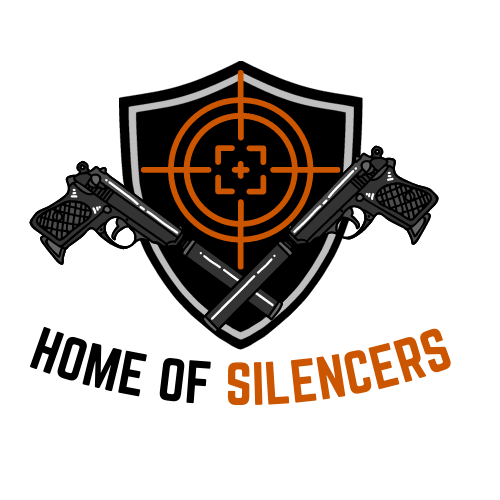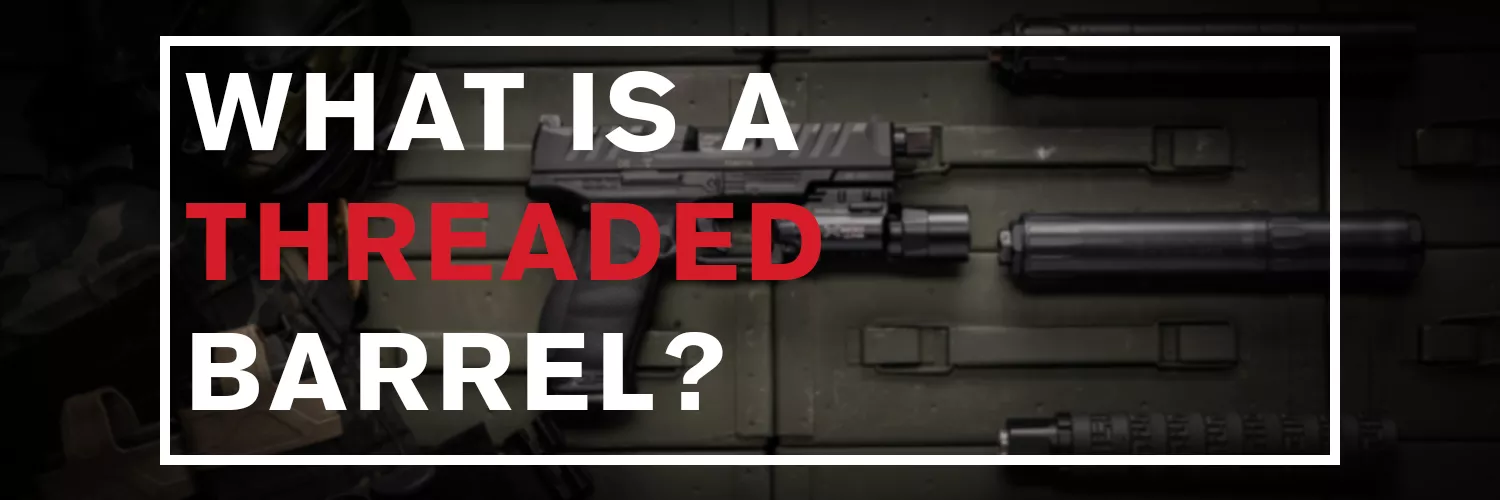There are 77+ Million gun owners in the US, and many of them ask us how to improve their shooting experience with a threaded barrel. Adding a threaded barrel to your gun is easy, cost-effective, and allows you to utilize many firearms accessories such as gun suppressors. Let’s talk about pro tips for how to get your threaded gun barrel.
A threaded barrel has external threads at the end of the muzzle, which allows you to utilize various attachments such as a suppressor or other muzzle devices. If your host firearm doesn’t have a threaded barrel, you’ll likely need to purchase a threaded barrel, or you can contact your local gunsmith for professional barrel threading in your area. If your gun already has a threaded barrel just determine the thread size, (covered below), then your host firearm could be all set.
Overview of Threaded Barrels
What is Threading On A Gun Barrel?
The threading on a gun barrel refers to the external grooves that are cut on the outside of your barrel. Gun barrel threads come in a wide variety of sizes. Once you’ve identified the dimensions of your barrel thread, you’ll be better able to choose a compatible muzzle device for your firearm. How do you know the size of a threaded barrel? Use a thread pitch gauge or measure the diameter of the threads, the pitch of the threads, and the direction that the device tightens to the barrel.

Credit: @internationalbarrels
How do you determine thread size?
The thread size of a threaded barrel for a gun is determined by two numbers: 1) the diameter and 2) the pitch of the screw threads. The first number is the diameter, and the second is the thread pitch (or thread size/coarseness). For example, the 1/2×28 muzzle threads for most .22 caliber firearms, including .22 LR and .223/5.56, where “½” is the diameter of the threaded section in inches (half inch) and “x28” is the number of threads per inch of threaded section length. Having exact measurements of your threaded gun barrel is important to ensure the compatibility of your firearm and suppressor. Note: even when the same company manufactures the firearm and suppressor, it’s possible the two will not be compatible if the measurements are not identical. Additionally, the caliber in which you shoot can be a contributing factor to what your thread size will be. Some suppressors have threads cut directly into them, meaning the suppressor thread pitch is fixed and cannot be changed (example: CGS Helios DT). Other suppressors have removable and interchangeable mounts (such as SilencerCo Omega 300 or YHM Turbo T2), allowing you to easily swap for a mount compatible with those specific barrel threads. If your threaded barrel and suppressor are not compatible, there is a possible solution whereby you can make them work together: a barrel thread adapter could be used as a bridge between the barrel and suppressor.
What is Thread Pitch?
Thread pitch is the distance between screw threads, and this distance determines the size of the threads (also known as the coarseness or fineness of the threads). You’ll know the thread pitch for your firearm by measuring and counting how many threads are in a given length of threaded section. In standard/Imperial screw sizes, we count the number of Threads Per Inch or TPI. For example, a thread size ending in “x28” has 28 threads per inch of threaded section. A higher TPI number means finer threads, as more of them are packed into that same inch of threaded section. The measurement of your firearm may be designated in metric size, for example, M13.5×1 LH. If you see “M”, preceding the thread size, that letter denotes Metric. With metric fasteners, the thread pitch is expressed as the distance, in millimeters, between threads (i.e. from peak to peak). For example, a metric thread size ending in “x1.5” means 1.5mm of space from thread to thread. The smaller the number, the finer the threads.
Right Hand (RH) vs. Left Hand (LH) Threads
Determining the Right Hand (RH) or Left Hand (LH) is important because this designates the direction in which the threads turn. RH is the most common thread direction for American firearms and you’ll turn clockwise to tighten (AKA “righty-tighty”). Left-hand threaded barrels turn counterclockwise to tighten and are prevalent in European manufacturing (which is also likely to use metric measurements). For example, a SIG Sauer MCX-Spear features 5/8×24 RH threads, and a Kalashnikov AK-47 uses M14x1 LH muzzle threads.

Photo credit: @Surefire_llc
What is The Most Common Threaded Barrel?
The most common threaded barrels are 1/2×28 TPI, 5/8×24 TPI, and .578×28 TPI. Popular suppressor manufacturers (such as Dead Air, Griffin Armament, and SilencerCo) also use the threaded sizes below. The uniformity was created to standardize barrel thread sizes with barrel calibers:
- 1/2×28 TPI: everything up through .224 caliber (.17 HMR, .22 LR, .223/5.56, .22-250, 5.7×28, etc.) plus 9x19mm (your standard 9mm pistol ammo) and .350 Legend
- 5/8×24 TPI: everything over .224 caliber through .30 caliber (.243 cal, 6mm, .264 cal, 6.5mm, 6.8mm, .28 cal, 7mm, 7.62mm and .30 cal including .308 Win, 300 BLK, .300 Win Mag, etc.) plus 375 Raptor. Sometimes .450 Bushmaster, .458 SOCOM, and others will employ 5/8×24” threads.
- M13.5×1 LH: some German/European 9mm pistols such as GLOCK and Sig Sauer
- M14x1 LH: most AK-47s. An exception is modern, U.S.-made barrels that often use the more U.S.-standard 7.62mm 5/8×24 threads.
- .578×28 TPI: most .45 ACP handguns. Also many .40 S&W and 10mm Auto
- 9/16×24 TPI: common for .40 S&W and 10mm Auto as well as some large bore rifles
- 11/16×24 TPI and 3/4×24 TPI: used in many big bore applications, from .338 Lapua Mag up through .458 SOCOM and more. For anything over .30 caliber / 7.62mm, make sure to check with the barrel manufacturer or otherwise verify your barrel thread size.
Common Barrel Threading Questions
How are Gun Barrels Threaded?
Gun barrels are commonly threaded by using a CNC lathe. A lathe is able to provide greater precision as opposed to threading by hand. While hand threading can be done, modern techniques and machinery have improved concentricity and consistency for threading barrels.

Is It Worth Getting a Threaded Barrel?
A threaded barrel is worth getting: especially when you’re looking to put a suppressor or other muzzle device on your firearm. Threaded barrels allow you to customize your firearm(s) with accessories, allowing you to shoot suppressed which enhancing recoil mitigation and sound dappening, especially positive for gun competitions, hunting or tactical drills.
Will Thread a Barrel Affect Accuracy?
Your accuracy will be on par or improved while shooting a firearm with a threaded barrel because you will be able to shoot suppressed, and you’ll have more accurate follow-up shots due to reduced recoil.
Can You Thread a Barrel on a Pistol?
Yes, you can buy threaded pistol barrels. Note, if you’re planning to attach a suppressor to your pistol, a booster assembly may be required. A booster assembly allows pistols with tilting barrels to be shot suppressed and still cycle properly.

Photo credit: @SilencerCo
Conclusion
There is a multitude of benefits of having a threaded barrel, the primary reason being to be able to shoot suppressed. When choosing which threaded barrel is right for you, verify the thread pitch of the barrel and the device you’re going to mount. After determining compatibility, you can focus on the brand(s) that you trust, using manufacturer-provided details from the top-selling NFA brands such as SilencerCo, Sig Sauer, Griffin Armament, Daniel Defense, and more.

